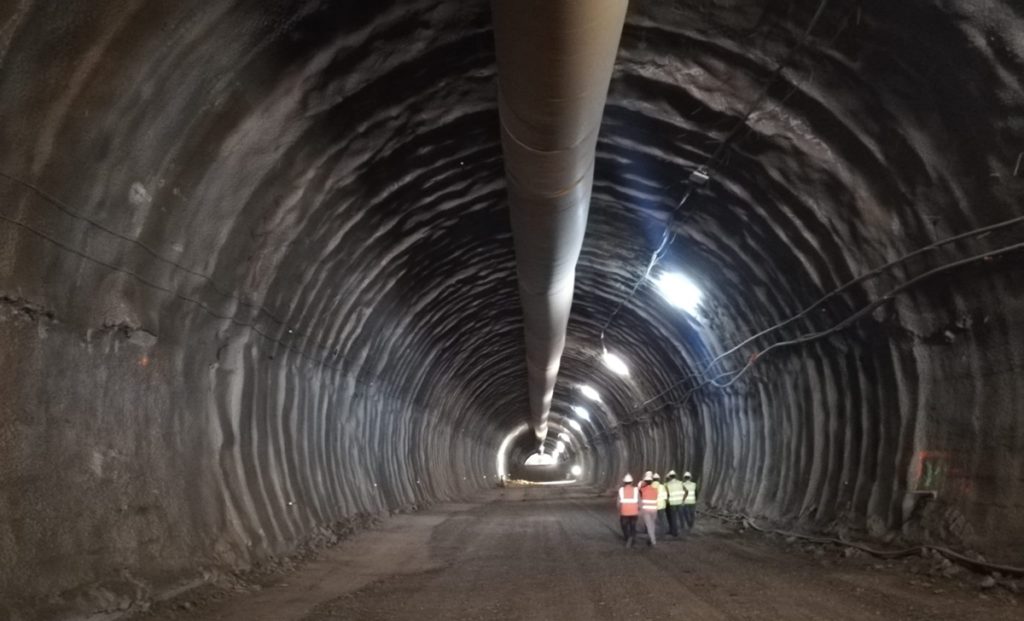
The work with the largest budget currently being carried out in Spain, the construction of the Erjos double tunnel, which will cross the Teno massif and connect the north with the south of Tenerife, is progressing at a “reasonable” pace, as confirmed to DIARIO DE NOTICES the Ministry of Public Works of the Government of the Canary Islands. The works, quite a challenge for modern engineering, are carried out simultaneously in Santiago del Teide and El Tanque, where two parallel mouths are drilled in each municipality that will be found inside the mountain.
Of the 5.1 kilometers that will be dug through each tunnel, the main obstacle of the Insular Ring, the machines have already drilled more than 1,100 meters in the southern section, the most advanced. These are works carried out by special robotic drilling machines that use water and percussion to combat the hardness of the basalt. The procedure is highly complex: once the hollow space of approximately three meters has been opened, the explosives are placed, connected to some computers, which are in charge of activating the controlled detonations. Next, the demolished material is removed, loaded onto trucks and taken outside. From there the cycle restarts.
As explained to DIARIO DE AVISOS by José Luis Delgado, General Director of Road Infrastructure of the Government of the Canary Islands, the underground work is advancing at a rate of between 3 and 4 meters per day in each tunnel along the southern section (between 6 and 8 meters if we add both), while in the north mouth it is penetrated at a lower speed, between 1 and 2.5 meters per day, due to the difficulties that the operators are encountering, who advance between slag waiting for the basalt to come out to their meeting.
“My hope is that in a couple of weeks we will already find basalt and we can give the stretch in the north that would allow us to speed up the excavations considerably,” said Delgado, who insisted that, despite the setbacks, the works are being carried out “in time and form”.
But, in addition to the difficulties that workers find underground, Delgado underlined another of the drawbacks that an underground work of this magnitude poses and that forces technicians to spin very fine: “The most important thing is that the works are correctly georeferenced , because if an error occurs and there is a slight deviation, the tunnels are not found, and due to the characteristics of the work, it cannot be referenced by satellites, because they do not reach the depth at which work is being carried out, which can reach up to the 400 meters.
erjo ponds
Delgado also confirmed that, after excavating more than a kilometer in the municipality of Santiago del Teide, the machines have already passed the Erjos ponds. “We have already left them behind, so the danger that they could be emptied has been shown not to be real,” he said.
The works on the section between Santiago del Teide and El Tanque, awarded for a value of 240,370,796 euros to the Temporary Union of Companies formed by Fomento Construcciones y Contratas (FCC), El Silbo and Syocsa-Inarsa, began on November 25, 2019 and have an execution period of 48 months. It is a fundamental infrastructure to improve mobility and connectivity between the north and south of the Island through a safer, faster and higher capacity road than the current one, the TF-82 highway. Once it comes into service, the drivers will cover the distance between El Tanque and Santiago del Teide in less than 10 minutes, that is, a time almost three times less than that used with the current route.
The general director of Road Infrastructure indicated that, once the double tunnel and the section of the Insular Ring between San Juan de la Rambla and Icod de los Vinos are finished, around 30,000 vehicles that travel along the North highway every day will make the journey through the South. “I only ask the citizens who suffer from queues on the TF-5 to have a little confidence. We are trying to do in these four years what has not been done in the last 15”, said José Luis Delgado.














This will cause even more problema in the south. Los Cristianos and Las Américas are already full to capacita with traffic jamás on the TF1. This will destroy the south of Tenerife and the turismo industry!